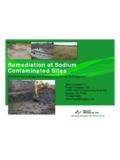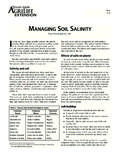Transcription of Wetting agents: What are they, and how do they work?
1 A betterunderstandingof howwettingagentsworkwillleadto theirmoreeffectiveuseon thestructureof charge,sur-factantsarecommonlyseparatedi ntofourmajorgroups:anionic,cationic, , theirnegativecharge(anion)andpositivecha rge(cations), watersolutions,whereasamphotericsurfacta ntscanbeeitheranionicorcationicdepending ontheacidityof reactingwithotherionsin thesolution,causinga precipitateor foamto ,theydonotforminsolublesaltswithcalcium, magnesiumor strongacidsolutionsandtendto haverelativelylowtoxicityto today'ssoilwettingagentsusedin ,"Whataboutsoaps?"Soapsarea typeof surfactant;cantheybe usedas a soilwettingagent?
2 Althoughsoapshavebotha polarendanda nonpolarend,theyowetheirsurfactantproper tiestoananionicportionof , ,calciumandferricionsin ,soapwouldnotbea goodsubsti-tutefora nonionicsurfactantor golfcarpaths,improvingfirmnessof bunkersand, wettingagentsin all ,whenusedin therightsituation,a wettingagentcanbe canan ,confusionaboutwhatwettingagentsareandho wtheyworkis thisarticleweexplainthecharacteristicsof wettingagentsandhowtheyworkin ,througha betterunder-standingof thechemicalnatureof wettingagents,superintendentswillbe ableto deter-minewhethera wettingagentwillbe effectivein a intoa classof chemicalcompoundscalledsurfactants,which arechemicalsthatcausea physicalchangeat theinterfacebetweentwoliquidsor betweenaliquidanda gasora liquidanda thesurface,theyareknownas"SURFaceACTiveA geNTs.
3 "Surfactantsarecommonlyusedinherbicidefo rmulationsto enhancethedesiredpropertiesof ,othertypesof surfactantsincludeemulsifiers,dispersant s,spreaders,pene-trants, morecharacteristicsincommon,butall possessthecommonfeatureofa water-soluble(hydrophilic)groupattachedt oa long,oil-soluble(lipophilic)hydrocarbonc hain(Figure1).Thesetwogroupsmaybe linkedtogetheror by an chemi-KEYIP ointsMoreInfo:ww~. thesailorsandparticle, wettingagentappliedto a non-water-repellentsoilwouldmostlikelyin creasethedownwardmove-,mentof wateroutof therootzoneanddecreasetheupwardcapillary move-mentof thewaterin wettingagentis appliedto anareawithexcessivethatchor mat,thatareadriesmoreslowlythananuntreat edareaat Karnok, ;KangXia, ;andKevinA.
4 TuckerWettingagents:Whatarethey,andhowdo theywork?Withoutquestion,soilwettingagen tshavebecomean surveyof morethan600superin-tendentsthatshowed87% usewettingagentsas partof theirregularmaintenanceprogramwhileanoth er11% usethemin thesurvey,wet-tingagentsareusedforfourpr imarypurposes:relievinglocalizeddryspots (42%),managingwater(32%),improvingdraina ge(11%)andimprovingpesticidemovementinto thesoil(9%).In addition,superinten-dentsusewettingagent sfora varietyof otherreasonssuchas reducingdewandfrostfor-mation,improvings eedgermination,reduc-ingfairyringdamage, reducingsoilcompaction,improvingirrigati onefficiency,84 GeMJune2004 Figure1.
5 A typicalwettingagentmoleculeshowinga hydrophilicwater-attractinggroupanda long,oil-soluble(lipophilic) hasbeenwelldocumentedthatsoilwaterrepell encyresultinginlocalizeddryspotsis theresultof anorganic(nonpolar)coatingthatadheresto theindividualsoilor-in mostcases---,sandparticle(Figure3).Thiso rganicmaterialis sev-eralarticlesin GolfCourseManagement(seereferenceslist). TheimportantpointtoSurfacetensionAnother significanttraitof wateris thetendencyofthesurfacemoleculesof a whya singlewaterdropletonwaxpaperappearsas thoughithasa tense, ,a smallsewingnee-dlewillfloatonthesurfaceo f purewaterbecausetheneedleisn' ,if a wettingagentis addedto thewater,thesurfacetension(thatis,theatt ractionof watermoleculestoeachother)
6 Is reduced, ,if asurfactant,whichhasbothpolarandnonpo-la rportions,is addedto water,thewateris thewettingagentbondswiththenonpolaroil,a ndthepolarportionbondswiththewater, surfactantor wet-tingagentworksin a turfgrasssituation,it a dipolarsubstance,whichmeansit hasbothnegativeandpositivepolarends(Figu re2).Theuniquepropertiesof waterareduetothispolarity,whichallowsit to formbondswitha varietyof , fact,waterandotherpolarsubstanceswillbe tryingtomixwaterOil-SolubleHydrocarbonCh ain(L1 POPHIL1C/NONPOLAR)Chemistryof waterWater-SolubleGroup(HYDROPHILIC/POLA R) Figure2.
7 Wateris a dipolarsubstancethatcon-sistsof twohydrogenatoms(positivecharge)andoneox ygenatom(negativecharge). GeM85 June2004 RESEARCHN onpolarEndWillRepelWaterFigure4. Diagramof a sandparticlewitha (AttractsWater)HH'0/WaterMoleculeFigure5 . Diagramof a sandparticlewitha water-repellentorganiccoatingaftertreatm entwitha whenthisorganiccoatingcov-ersa significantamountof a soilor sandpar-ticle,theparticlewillrepelwater( Figure4).Whena wettingagentis addedtothewater,thepolarportionof thewettingagentbondswiththewaterwhilethe nonpolarpor-tionbondswiththenonpolarorga niccoat-ing,thusallowingthesoilor sandparticletowet(Figure5).
8 Fu longas thereis sufficientwettingagentbondingwiththeorga niccoat-ing,thesoilor sandparticlewillnotbe ,it shouldbe keptin mindthatthisalleviationof ,waterrepellencywillreturnwhentheuseof a wet-tingagentis matBecausewettingagentsaredesignedto haveanaffinityfornonpolaras wellas polarsub-stances,thenit standsto reasonthatexcessivethatchor otherwords,a wettingagentwillpotentiallybondwiththeth atchormatas readilyas it a turf-grasssitewithanexcessiveaccumulatio nofthatch,an areathathasbeentreatedwitha wet-tingagentwilldrysignificantlymoreslo wlythananuntreatedareaat partexplainstheobservationsomesuperinten dentshavemadethatcertainwettingagentsapp arentlyholdmoistureat thechemistryof certainwettingagents,86 GeMIJune2004ourresearchsuggeststhattheam ount-andpossiblyeventhenature-of thethatchor matis at leastas importantor perhapsa this point,weareunsureas to howmuchthatchor matis betterunderstandtherelationshipsamongtha tchor mat,organicmatterandtheperformanceof.
9 "Whathappenswhena wettingagentis appliedto a non-water-repellentsoilor sand?"In agreementwiththereasoningdiscussedabove, ona sitewithlittleor nothatchor matandtheabsenceof water-repellentsoil,a wettingagentwouldhavelittleeffectontheso ilitselfHowever,a wettingagentwouldreducethesurfacetension andattractionof watermoleculesto eachother,makingwater"wetter."Thiseffect wouldmostlikelyincreasethedownwardmoveme ntof wateroutof therootwne(providingtherewassubsurfacedr ainage)whiledecreasingtheupwardcapillary movementof thewaterin ,includinghow, , (6) , , (eds.). :Chemistry,interfacialproperties, , , , soilhydropho-bicityon ,K.
10 , hydrophobicsoil:Whathavewelearned?GolfCo urseManagement63(8) , , (5) , , (6) , , (7) , , flu-tolanilfungicideandPrimerwettingagen ton (3) ,K.,andK. ,PartI. Wherearewenow?GolfCourseManagement70(6) ,K.,andK. ,PartII. (7) , , , (6) ,KA, , ,G. LandryJr., causedby hydrophobicsandon , , a professorof tUrfgrassscienceandKangXia, ,is anassis-tantprofessorof environmentalsoilsciencein thedepartmentof cropandsoilsciencesat theUniversityof Tuckeris a GCSAA educationseminarsin Orlando.






